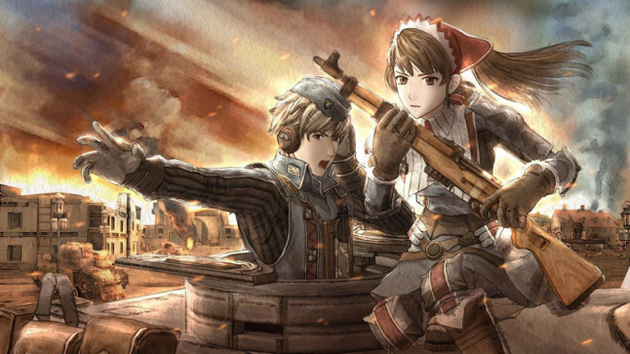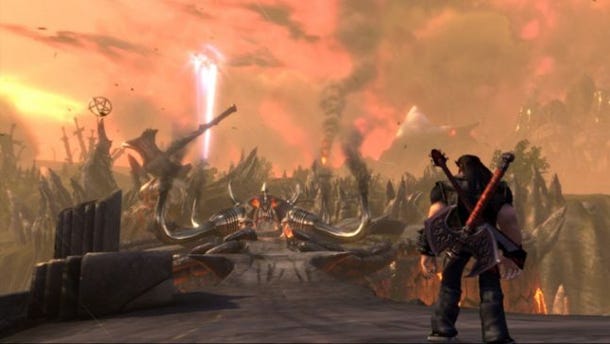
Featured Blog | This community-written post highlights the best of what the game industry has to offer. Read more like it on the Game Developer Blogs.
A design article that explains how developers can enhance the presentation of their games and make it more idiosyncratic and noteworthy.

For centuries, human beings made use of mediums such as literature, film and theater to communicate their beliefs and values in a stylish fashion and capture the attention of their audiences through the collective unconscious. This broad sharing of ideas through an imaginative filter, presentation, represents an indispensable artistic component that extends to all artworks and shapes the way the participant perceives them. This same age-old concept also applies to an art form that, although young, embodies a complex and flexible design structure: video gaming.
In the early years of gaming, developers made use of multiple stock premises such as the Middle Ages (e.g. King's Quest) and the future (e.g. Metroid) to immerse the participant into the experience, with the medley of audiovisuals and interactivity making the otherwise commonplace themes seem somewhat fresh. As time went on and gaming generations came and went, designers discovered new and inventive ways to craft the presentation of their games by leveraging new audiovisual technology and/or mixing & matching various themes for added memorability.

Today, video game production has become unequivocally more sophisticated and advanced, which means that designers are capable of crafting modern experiences that generally sport multilayered and unorthodox elements like Red Steel 2 and Valkyria Chronicles. But it seems that we have just scratched the presentational surface given that similar narratives, themes and audiovisual qualities get rehashed in a lot of titles. This is something that developers should quickly remedy if they are to advance our expansive medium and make their games more noteworthy.
As an art form with the added benefit of interactivity, video gaming opens up innumerable avenues that invite presentational experimentation and make room for thematic and audiovisual novelty. This, along with a sound experience goal-setting and brainstorming process, enables designers to make full use of the various techniques, themes and references they have at their disposal to deliver matchless and profound games that can potentially be more creative and immersive than what can be achieved in other artistic and entertainment areas.
I'll elaborate on that topic by providing you with five tips and tricks to take into consideration when trying to enhance the presentation of your game and make it more distinct as a whole. For each piece of advice, I'll include an example of a game that gets that particular aspect right.
NOTE: The tips that I'm sharing with you may or may not be compatible with every game depending on the designer's philosophy and vision, but they serve as general guidelines that can benefit the virtual experience when well-implemented.
1-Enhance the identity of the title to make it distinctive
One of the first endeavors that developers have to undertake while coming up with the experience goal for their game is to ensure that the title boasts a prominent personality and soul that will greatly complement the gameplay and other design aspects of the overall package. This is important because identity serves as one of the critical components of memorability, and a game that lacks character can end up feeling ho-hum and forgettable, which aren't adjectives one would want to associate with their title if they're trying to stand out from the pack. Carving a unique persona requires embracing a particular theme and then baking it into every aspect of the game in creative ways that turn the experience into one that perpetually astounds the player.
Double Fine's Brutal Legend is a great example of a title whose presentation fully takes advantage of the tone it's going for in order to shape the personality of the experience and make it all the more special. The action-adventure/RTS hybrid enhances its heavy metal theme and tone to monolithic heights by combining it with the richness of Norse mythology and the fantastical undertones that metal album covers imply, a medley that is appropriately reflected in the colorful characters, the larger-than-life environments, and of course, the energetic soundtrack. The result is a game that oozes style and substance across all facets of the presentation and creatively pays tribute to its subject matter, making for a truly memorable and marvelous experience.

Like all artistic and entertainment works, video games act as a way for developers to express themselves through the content they implement into their title, and like human beings, games are capable of embodying a soul, one that's lovingly displayed throughout the length of the adventure. This is why it's important for designers to go to great lengths to ensure that what they want to depict is actually implemented in the game, and this goal can be accomplished by taking the time to shape and assemble the theme in various and imaginative ways. Perseverance can go an incredibly long way towards establishing a characteristic tone that drives the experience and harmonizes with the title's other design intricacies.
2-Leverage as many sources as possible
In addition to imbuing the experience with an eminent identity, the designers should also strongly consider making said identity idiosyncratic by looking at and utilizing sundry inspirations in order to amalgamate them into one cohesive whole. In fact, the broader the developers' pool of thematic influences, the more fresh ideas they'll be able to come up with, which in turn begets a rich presentational bedrock for memorable scenarios and interactions. Given that video games need to make a solid first impression to pull the player into the experience, taking the time to spice up the "reference salad" and make it more toothsome will greatly benefit the developers and their titles in the long run.
Eidos Montreal's Deus Ex: Human Revolution lucidly takes that presentational aspect seriously with its unique mix of elements that span multiple centuries but share a common and unified philosophy. In this action RPG, the player is dropped into a world where cybernetic augmentations serve as the main cause of social stratification. The ethics of transhumanism that permeate the game are punctuated by a prominent Renaissance theme and clever allegories to the Greek myths of Icarus and Daedalus that represent technological pace and class divisions. This amalgamation of historical references and futuristic themes allows Human Revolution to portray a multifaceted universe that is more than the sum of its intriguing parts.

Having an audiovisual presentation in your game that borrows from a wide array of real-life and fictional works can tremendously transform the experience and enable it to forge an identity of its own, making it all the more noticeable and distinct from other releases in the market and within the same genre. A game that fails to take that into consideration can end up drowning in the sea of cookie-cutter titles, which is why designers should make the effort to take a careful look at what they want their title to convey and look/sound/feel like, and what the work-in-progress actually possesses. That way, they'll be able to tweak the presentation multiple times until they reach a sweet spot that provides a thematically varied and vivid experience.
3-Portray the experience in a stylish/creative fashion
Another way the designer can strengthen their title's presentation and turn the game into a creatively designed adventure is to depict the entire experience as something that transcends its video game nature. By that, I mean that developers ought to take a meticulous look at the style they're going for and figure out what they can do to portray it in the most faithful and inventive way possible. Not only can this endeavor enhance the other design elements that are heavily shaped by the experience goal, but it also ensures that the developers will be able to clearly and effectively illustrate the presentational qualities of their work to players and elevate the entire title beyond its "gamey" boundaries.
The Max Payne titles are reputed for their nifty and clever take on narrative and aesthetics, which can be attributed to their well-executed homage to film noir and graphic novels. The use of comic panel-style cutscenes (coupled with text and voice-overs) enhance the nuanced approach to storytelling, while the introspective monologues that Max delivers in and out of gameplay enable the player to become invested in the protagonist as he attempts to overcome his plights, in a way similar to that of neo-noir productions. When blended with the grim tone that is emblematic of Remedy's shooter series, the audiovisual presentation turns the gaming experience into one that gracefully channels several pop culture mediums to accentuate its style.

One of the amazing things about video games is that they possess attributes that are shared by many other mediums such as literature and film. This essentially means that gaming is capable of assuming multiple forms that can shape the experience without looking jarring or out-of-place. This is something that designers should keep in mind when brainstorming about ways to make their title look and feel distinctive. By understanding the core values/components of different art forms and expanding their knowledge of the topics/themes they wish to incorporate into their work, developers can craft presentationally and thematically riveting games that treat their structural influences with respect.
4-Maintain a consistent and smooth immersive flow
Of course, designing a distinct and noteworthy presentation is just half the battle when it comes to creating an indelible and impeccable game. Preserving the audiovisual fidelity throughout the length of the experience is also an important goal that the designer should strive to accomplish in order to maximize the immersion factor. Whether it's sticking to a specific perspective/gameplay state (e.g. Half-Life) or building the environment in a way that feels connected and cohesive (e.g. Dark Souls) with little to no seams, a steady immersive flow ensures that the player will be sucked into the virtual experience and never be taken out of it by technical or audiovisual quirks that can distract from the elements that the designer painstakingly handcrafted.
2010's Limbo does an amazing job of immersing the gamer into the experience with its minimalistic and poignant presentation that manages to feel incredibly effective and smooth throughout the entirety of the adventure. The title's lack of loading times and "less is more" approach to aesthetics & audio enable the player to better absorb and appreciate the attention-to-detail strewn about the eerie environment without being taken out of the experience by audiovisual outliers such as technical bugs and incongruous assets. Limbo's seamless design and continuous structure allows the presentation to carry much of the abstract story's weight and fully engross the player in the arresting and nebulous journey to the point where they forget they're playing a game.

Immersion is one of video gaming's most vital and precious qualities. It allows the player to get fully involved into the virtual world's goings-on and become a part of it while they are exploring and interacting with it, which is why maintaining the consistency of the presentation is an endeavor that designers should undertake if they are to deliver a game that will linger in the minds of gamers long after they've completed the adventure. By figuring out how to build the title in a way that minimizes seams and weaves the sundry design elements that make up the package, developers will be able to create a game that feels smoothly contiguous in its structure and displays its thematic and audiovisual details in the best possible light.
5-Make the game world feel deep and expansive
If the developers want to go the extra mile and deliver an experience with a pronounced aura of virtual escapism, they can always prioritize one of the core aspects of a title's presentation: the game world. As the indispensable vessel for player interaction, the environment serves an incredibly valuable purpose that involves bedazzling the gamer with imaginative locales, compelling characters, and intriguing lore. By leveraging the presentational components that complement world-building, the developers can transplant all of the thematic references and ideas they garnered and came up with into the game environment in a way that makes them inseparable from the surroundings that the player will explore.
The Elder Scrolls games have developed a well-earned reputation for placing players in massive and detailed open-worlds that surprise them at every turn. The continent of Tamriel, which serves as the setting for all TES games, not only daunts the player with the size and scope of its provinces, but it also possesses an extensive backstory and array of personal tales that are forged into the sundry repositories that the player comes across (e.g. dungeons, books, cities...). All of these components serve to make each game in Bethesda's flagship franchise a truly otherworldly and epic experience that greatly benefits from the complexity and attention-to-detail that the designers incorporated into the physical environments and the overall universe.

Creating a virtual environment that is both audibly and visually marvelous to behold is something that the developer should strive to accomplish in order to enthrall players, but they should also consider imbuing said environment with a unique and interesting story that gives purpose and meaning to the various locations and inhabitants. This is where designers can truly take advantage of their intellect and knowledge to form a fictional universe with a potent sense of history and wonder that leaves plenty of room for exciting scenarios and interactions. A game world that is both enticing to explore and learn about ensures that the developers will be able to not only draw the player's attention, but to keep it for the duration of the journey as well.
Perhaps the biggest boon video games have as an interactive medium is that they are capable of utilizing their numerous components to craft a multilayered experience that enraptures players and holds their attention in the long run. This makes the presentation a component that designers should strongly prioritize (along with gameplay) during development in order to sustain the wondrous and novel nature of the journey. With the above pieces of advice that I've given, developers can leverage the sources and resources they have at their disposal and forge a title that, when equipped with recombinant creativity, can potentially offer to the gamer one of the most distinct and unforgettable experiences they'll ever play.
Let me know what you think of my article in the comments section, and feel free to ask me questions! I’ll do my best to get back to you as promptly as possible.
Read more about:
Featured BlogsAbout the Author(s)
You May Also Like







